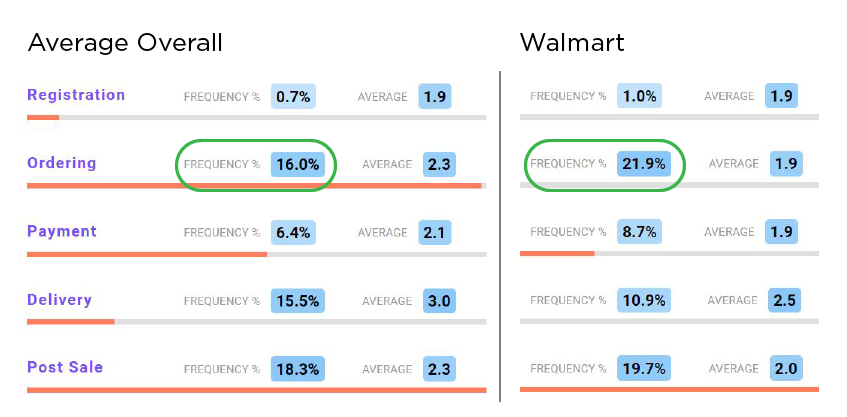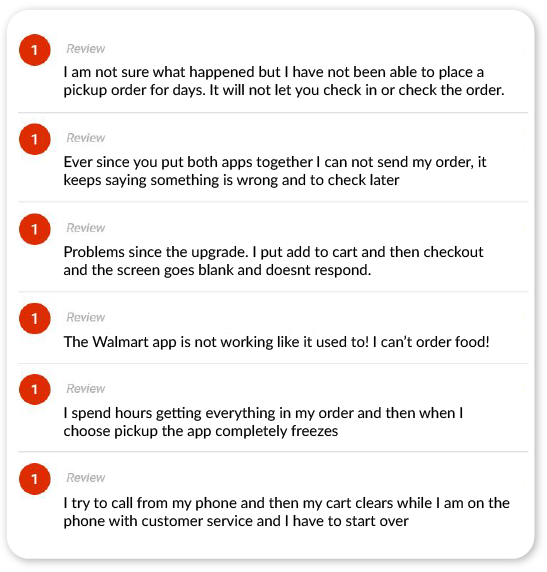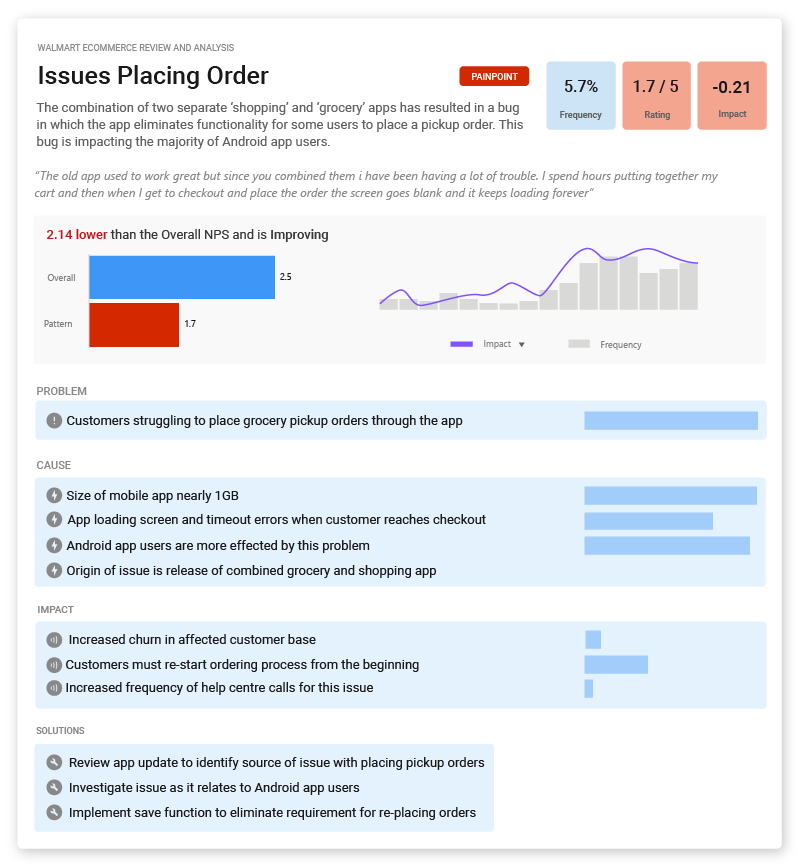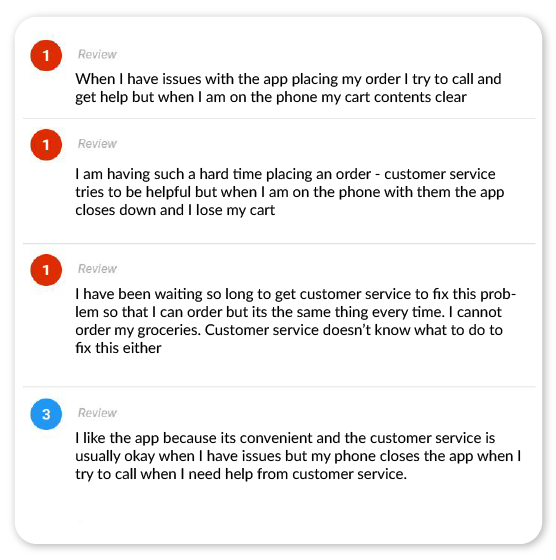This is the third and final instalment in a series of blog posts focusing on the Touchpoint Ipiphany eCommerce analysis and review. Touchpoint Group offers the unique opportunity for eCommerce organisations to analyse not only their own review feedback but also that of in-market competitors, in order to help businesses identify and prioritise improvements that will have a measurable impact on their RoI. Today we delve deeper into the Customer Experience Journey framework, expanding on the research conducted as part of the Walmart Case study.
What is the Customer Experience Journey Framework?
You’re committed to improving RoI through customer experience, and you’re looking for a way to make data-driven improvements to your customer journey. The Customer Experience Journey Framework has been developed by Touchpoint Group to help you analyse and understand not only the experiences your customers have as they purchase from your eCommerce platform, but also how you can use this information to identify the root cause of problems and rising concerns emerging in your data.
This framework helps you identify, quantify, and react quickly to issues your customers are experiencing so that you can make data-driven decisions on what causes churn, contributes to RoI, and impacts your customer journey. Unstructured text data is just that: Unstructured. Using a systematic approach combined with the power of AI customer analytics in Ipiphany will help you extract the greatest value possible and apply it in the most meaningful way; driving quantifiable business outcomes and ultimately improving customer experience.
In this example, we’ll use the public review data collected from Walmart’s eCommerce platform to understand how to analyse individual components of the customer experience journey, and how these components interact with each other.
How Ipiphany performs this analysis
The Ipiphany AI uses NLP (natural language processing) to understand and categorise comments, and the Touchpoint Team has trained it to categorise their experiences based on stages of the customer journey. The result? An easily digestible list broken down into the key aspects of customer interaction. They are as follows:
- Registration (subtopics include signing up for an account, creating a username, etc.)
- Ordering (website search, browsing, ease of access to product information)
- Payment (security issues, cart usability, coupons and gift cards)
- Delivery (delivery cost and speed, delivery partners, click & collect or pickup)
- Post-Sale (returns, warranty, customer care, account updates)
This structure makes it easy to understand the source of any issue your customers experience, but also to clearly identify the way an issue might impact multiple stages of the customer journey.
Critically, we can also perform a competitor analysis using public review data to help you gain a clear, data-driven understanding of your own market performance and ranking. Using the Customer Experience Journey framework, we can compare the average frequency that customers discuss each element of their experience with, and use that information as a benchmark to understand what normal baselines we might expect, and what is unusual. In the Walmart case study, this methodology allowed us to uncover the stock control issue Walmart retail centres were experiencing when we noticed that customers discussed “ordering” at 16% frequency, while this frequency exploded to 21.9% when Ipiphany isolated Walmart customers.

Achieving actionable, data-driven results
In our last post when we explored trend analysis, we uncovered a pair of issues called “Cancel order” and “Place order”. While we expanded on “Cancel order” in that post, we decided to save “Place order” as it’s a separate, more complex issue.
On the surface, it doesn’t seem complex at all: we can assume that customers are having some kind of problem when they place an order. Understanding that this is true, however, doesn’t give Walmart enough information to solve the problem for their customers. Ipiphany has grouped together some of the other frequently mentioned topics in “ordering”, and by investigating a few of these in-depth, we’re able to get a much clearer picture of exactly what is happening and understand the relationships involved.

Unlike the “Cancel Order” issue from last week, customers don’t seem to understand what is going wrong - they understand the app runs slowly when they try to place an order and that they have to make multiple attempts. Some have realised that it seems to affect grocery orders specifically, and others mention an update: but no single customer has all of the answers. However, each one offers a piece of the puzzle, and we can use Ipiphany to connect the dots and eliminate any superfluous information.
Ipiphany clearly describes the issue that customers are experiencing and outlines the facets of the problem, its causes and the way it affects churn and customer wallet share and allows for the suggestion of solutions that will fix the root cause of the problem. It also quantifies the impact that fixing the problem will have on the overall score. This allows you to predict how improvements will impact your metrics.

The Walmart Grocery and Shopping apps have been combined into one, and a resulting app update has eliminated the functionality for some users to place a pickup order specifically. 81% of reviews mentioning this issue are from the Google Play store, while only 18% are from the Apple App Store. Using this information, Walmart can rapidly narrow the focus from ‘all eCommerce customers placing orders’ to ‘customers using the Android version of the mobile app who are shopping for a grocery pickup order’.
This structured analysis provides relevant stakeholders in the Walmart app development team with enough information to investigate and fix this issue. It’s worth noting that the fallout from this issue echoes across the Post-Sale segment of the customer journey as well, as customers call the contact centre in an attempt to resolve the issue so they can order their groceries. This serves to compound the issue, as calling customer service on the same device they’re ordering from ends up resulting in additional complications, adding layers to the frustration these customers experience.

The Touchpoint Ipiphany eCommerce reporting and analysis service helps you conduct a thorough, data-driven analysis of your customer feedback, benchmark against competitors, and track the impact of changes both internally and externally. Whether you have public reviews to analyse or internal CRM data, ensure that you’re getting the highest value from every aspect of your data by including the unstructured data in your analysis with Ipiphany. To get started, get in touch with our team of experts today and ensure you’re doing everything you can to reduce churn, drive retention, and improve RoI.




